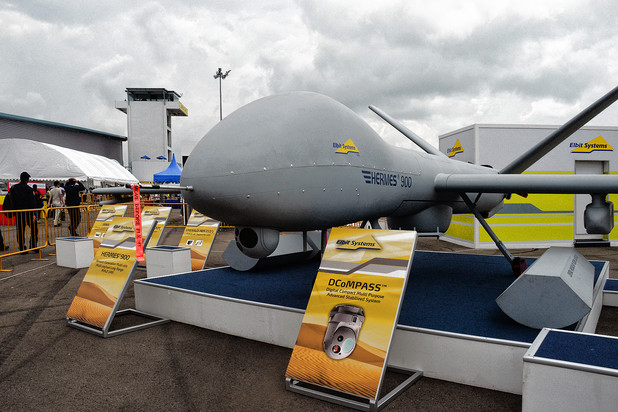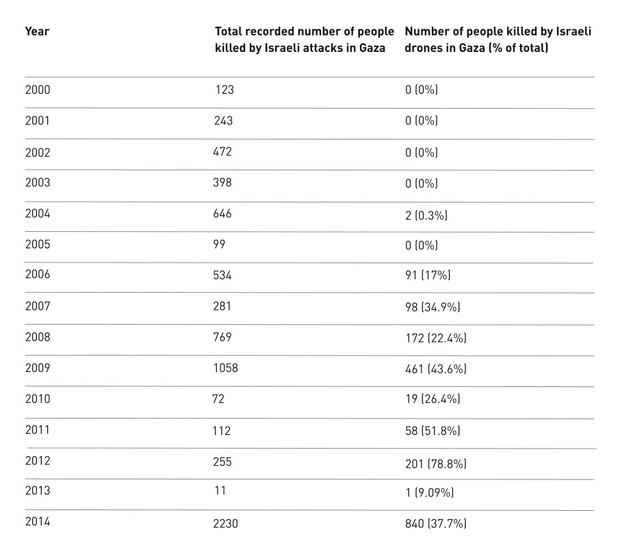Sixty Percent of Global Drone Exports Come from Israel — New Data
MILITARISM, 30 Mar 2015
Rania Khalek – The Electronic Intifada
24 Mar 2015 – Israel has supplied 60.7 percent of the world’s drones since 1985, according to new data from the Stockholm International Peace Research Institute.
As a result, Israel is the single greatest source of drone proliferation in the world.
In second place is the United States, which accounts for 23.9 percent of global drone exports, followed by Canada at 6.4 percent, France at 1.6 percent, Austria at 1.4 percent, Italy at 1.1 percent, Germany at 1 percent and China at 0.9 percent.
Conversely, the United Kingdom is the world’s number one importer of drones. Between 2010 and 2014, the UK bought 55 drones from Israel and six armed drones from the US, which accounted for one third of global drone deliveries in that time period.
The vast majority of the drone market is comprised of surveillance drones.
The US, UK and Israel are the only countries in the world known to have used armed drones, deployed exclusively against nonwhite predominantly Muslim populations in nations and territories that have been pillaged and destroyed by Western conquest.
The besieged Gaza Strip has served as the leading testing ground for both armed and surveillance drones.
Tested on Palestinians
Over the last decade, Israel’s use of robotic warfare against Palestinians has escalated dramatically, with each new military assault on Gaza relying more heavily on drones than the last.
Last summer, Israel’s 51-day bombing campaign against Gaza killed more than 2,200 Palestinians, the majority of them civilians, including more than 500 children.
Based on data collected by the Al Mezan Center for Human rights, a Corporate Watch investigation found that at least 37 percent of those killed, or 840 people, died in drone strikes alone.
Lost in the numbers is the psychological terror inflicted on the people of the Gaza ghetto, especially children, by the constant presence of drones buzzing overhead with the capacity to rain death on those below at any moment.
This has been wildly lucrative for Israeli arms companies, which exploit Israel’s frequent military assaults as opportunities to expedite the testing of their products on human subjects.
Easy access to a captive Palestinian population to experiment on allows Israeli arms producers to market their products as “combat proven,” a coveted seal of approval that gives Israel a competitive edge in the international arms trade. Israel’s repression technology is then exported to regimes that are similarly invested in subjugating the poor and marginalized.
This dystopian arrangement has paved the way for Israel, a country the size of New Jersey, to rank among the globe’s top arms exporters.
A case in point is Elbit Systems, Israel’s largest military technology firm, which produces 85 percent of the drones that make up the Israeli army’s vast arsenal.
The Hermes 900, a drone manufactured by Elbit, was deployed operationally for the first time against Palestinians in Gaza last summer, even though it was still undergoing testing. Nicknamed the Kochav — which is Hebrew for “star” — the Hermes 900’s blood-soaked performance garnered widespread praise at Israel’s annual drone conference, held less than a month after the Gaza slaughter.
The Hermes 900 is a more advanced version of the Hermes 450, an aerial attack and surveillance drone that was used by the Israeli army to deliberately target civilians in Gaza during Israel’s previous onslaught in late 2008 and early 2009, according to Human Rights Watch.
The Hermes drone was also used to kill civilians in Israel’s attack on Lebanon in 2006, including Red Cross workers, ambulance drivers and dozens of people fleeing their homes in a desperate search for safety from Israeli bombardment.
Marketed in the company brochure as “combat-proven” and “Fighting terror for over a decade,” the Hermes 450 boasts “a class-leading safety and reliability record.”
Apparently impressed by the aircraft’s capacity for bloodshed, the Brazilian government purchased a fleet of Hermes drones to help crush the massive protests that erupted across Brazil against the 2014 World Cup.
Thales UK — a subsidiary of the French company, Thales, which is ranked as the eleventh largest arms producer in the world — signed a $1.6 billion joint venture with Elbit Systems in 2011 to develop a new drone fleet called Watchkeeper for the British military.
The Watchkeeper is being modeled on the Hermes 450, which has been deployed by the British army in Afghanistan.
Elbit might be Israel’s largest drone producer, but it’s hardly the only Israeli company selling equipment tested on Palestinians to regimes around the world.
According to an investigation by Drones UK, Israel has exported drone technology to at least fifty different countries, enabling atrocities and fueling war.
With America’s blessing, Israel sold drones and fighter jets to Sri Lanka, which were used to commit atrocities against Sri Lanka’s ethnic Tamil minority.
South Korea recently purchased the Heron drone, which is produced by Israel Aerospace Industries and has been deployed for surveillance and target acquisition in Israeli attacks on Lebanon and Gaza.
In addition to helping crush World Cup protests, Israeli drones have been used by Brazilian police to invade the nation’s favelas.
In certain instances, Israel has sold drones to both sides in a given conflict. Both Russia and Georgia — between whom a conflict took place in 2008 — were armed with Israeli drones. Turkey and the Kurdistan Workers Party (PKK) have reportedly both used Israeli drones.
Meanwhile, Israel’s drone exports to India have provoked a drone “arms race” with neighboring Pakistan, according to the organization Drones UK.
Israel invented drones
Israel was instrumental in pioneering the modern drone due largely to the ideology at its core.
Israel’s creation as a majority Jewish state was precipitated by the pre-meditated ethnic cleansing of 750,000 indigenous Palestinians by Zionist militias in 1948 — which Palestinians refer to as the Nakba, or catastrophe. Israel has spent every day since then consolidating and expanding its Jewish majority in historic Palestine, which has required tremendous levels of violence, including the ongoing containment and exclusion of the native Palestinian inhabitants still under its control.
The Israeli economy has been built around advancing this goal, giving rise to a booming “homeland security” industry that caters to the designs of Zionism and then repackages occupation-style repression for export and profit.
Drone technology has been crucial to this endeavor.
After suffering heavy losses in its 1973 war with Egypt, the Israeli regime, for the first time in its existence, was met with backlash from an Israeli Jewish public unaccustomed to high soldier casualties.
It was in the aftermath of the 1973 war that the Israeli government began investing heavily in drone technology, minimizing the risk to its soldiers, effectively pacifying future opposition to endless war, expansion and conquest.
Israel Aerospace Industries, known as Israel Aircraft Industries at the time, and the Israeli company Tadiran were tasked with designing drones for real-time intelligence collection in the occupied Sinai.
Soon enough, IAI invented the Scout drone, which was deployed in 1982 to coordinate targeting during Israel’s deadly invasion of Lebanon. Throughout the 1980s and 1990s, Israel tested and refined a variety of drones on the people of southern Lebanon in an attempt to crush armed resistance to its occupation. With each operation came another wave of advancements in drone technology.
With the start of the second intifada and Israel’s forced withdraw from southern Lebanon in 2000, the occupied West Bank and Gaza became Israel’s primary testing grounds for drone warfare.
Israeli drones provided hidden attack helicopters with coordinates to fire on during Israel’s ruthless 2002 attack on the Jenin refugee camp in the West Bank. As early as 2004, Israeli drones were raining down missiles on the Gaza Strip in targeted assassinations of Palestinians fighters.
Though the US started utilizing and investing in drone technology before Israel, Israel was always one step ahead.
It’s no coincidence that Abraham Karem, an Israeli citizen, designed the Predator drone, which has been deployed by the US military and the CIA to carry out targeted assassinations that have left hundreds of innocent people dead. The Iraqi-born Karem received a degree in aeronautical engineering at the Haifa-based Israel Institute of Technology — better known as the Technion — and got his start at IAI before immigrating to the US after he was blackballed by the Israeli government for starting his own drone company.
Today, Gaza is surrounded with Israeli drones by air, land and sea.
In addition to the surveillance drones that hover overhead, the walls of the Gaza cage will soon be reinforced by Border Patroller, an unmanned ground vehicle (UGV), or land drone, armed with remote-controlled weapons. Designed by the Israeli company G-NIUS, a joint venture between Elbit Systems and IAI, the Border Patroller, like the walls it fortifies, will prevent the Palestinian refugees of Gaza from escaping their cage.
The Protector, produced by Israel’s Rafael Advanced Defense Systems, is an unmanned sea vehicle (USV), or boat drone, that roams Gaza’s coast to obstruct Palestinian fishermen from making a living.
If the proliferation of Israel’s aerial drones is any indication, it won’t be long before land and sea drones spread to all corners of the globe.
As long as Israel’s economy is shaped by the subjugation and elimination of Palestinians, it will continue to function as a factory for cutting-edge repression technology that sustains racism and inequality around the globe.
__________________________________
Rania Khalek is an independent journalist reporting on the underclass and marginalized. For more of her work check out her website Dispatches from the Underclass and follow her on Twitter @RaniaKhalek.
Go to Original – electronicintifada.net
DISCLAIMER: The statements, views and opinions expressed in pieces republished here are solely those of the authors and do not necessarily represent those of TMS. In accordance with title 17 U.S.C. section 107, this material is distributed without profit to those who have expressed a prior interest in receiving the included information for research and educational purposes. TMS has no affiliation whatsoever with the originator of this article nor is TMS endorsed or sponsored by the originator. “GO TO ORIGINAL” links are provided as a convenience to our readers and allow for verification of authenticity. However, as originating pages are often updated by their originating host sites, the versions posted may not match the versions our readers view when clicking the “GO TO ORIGINAL” links. This site contains copyrighted material the use of which has not always been specifically authorized by the copyright owner. We are making such material available in our efforts to advance understanding of environmental, political, human rights, economic, democracy, scientific, and social justice issues, etc. We believe this constitutes a ‘fair use’ of any such copyrighted material as provided for in section 107 of the US Copyright Law. In accordance with Title 17 U.S.C. Section 107, the material on this site is distributed without profit to those who have expressed a prior interest in receiving the included information for research and educational purposes. For more information go to: http://www.law.cornell.edu/uscode/17/107.shtml. If you wish to use copyrighted material from this site for purposes of your own that go beyond ‘fair use’, you must obtain permission from the copyright owner.

